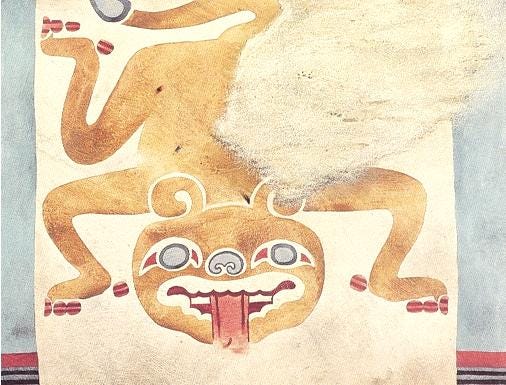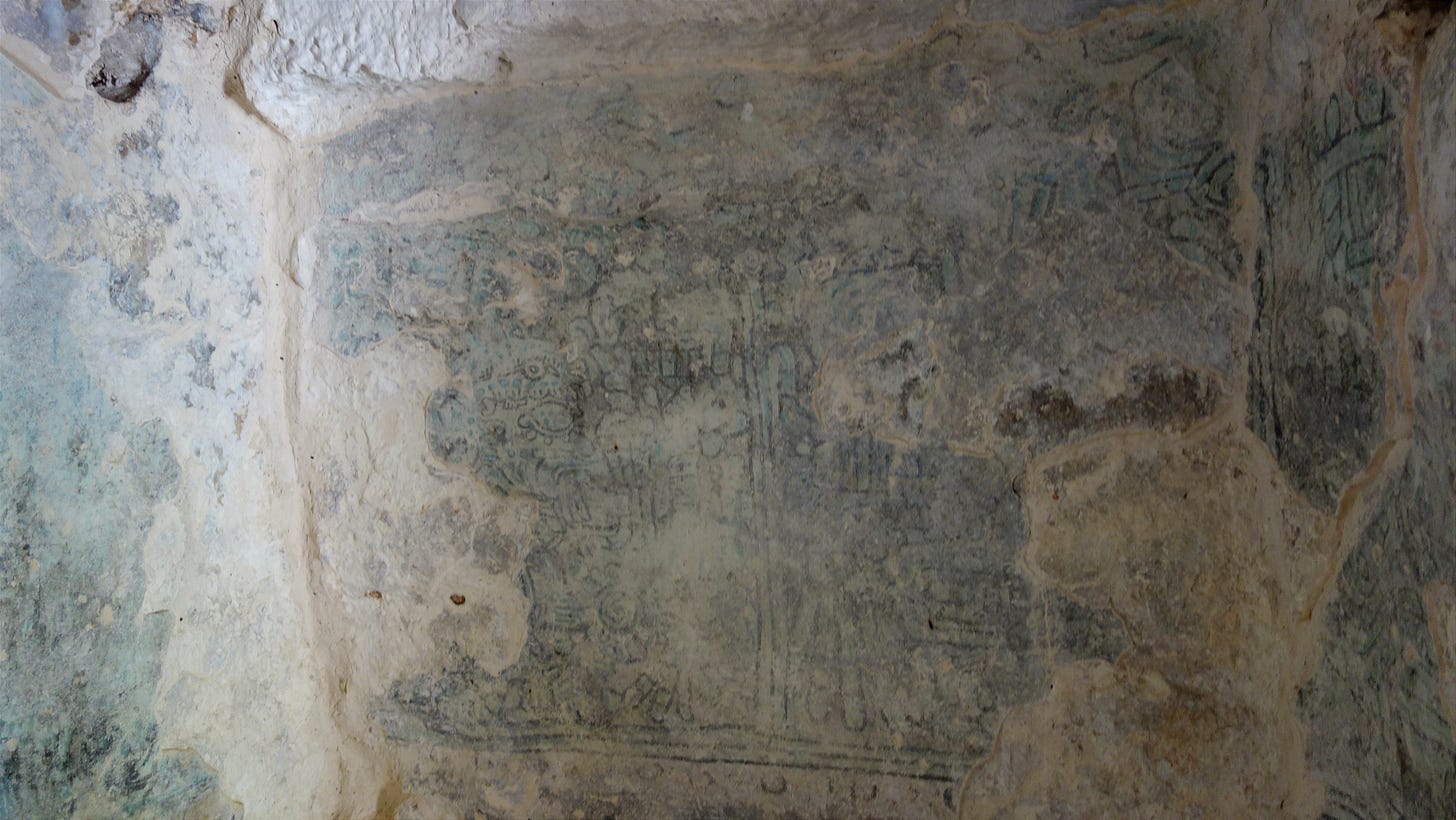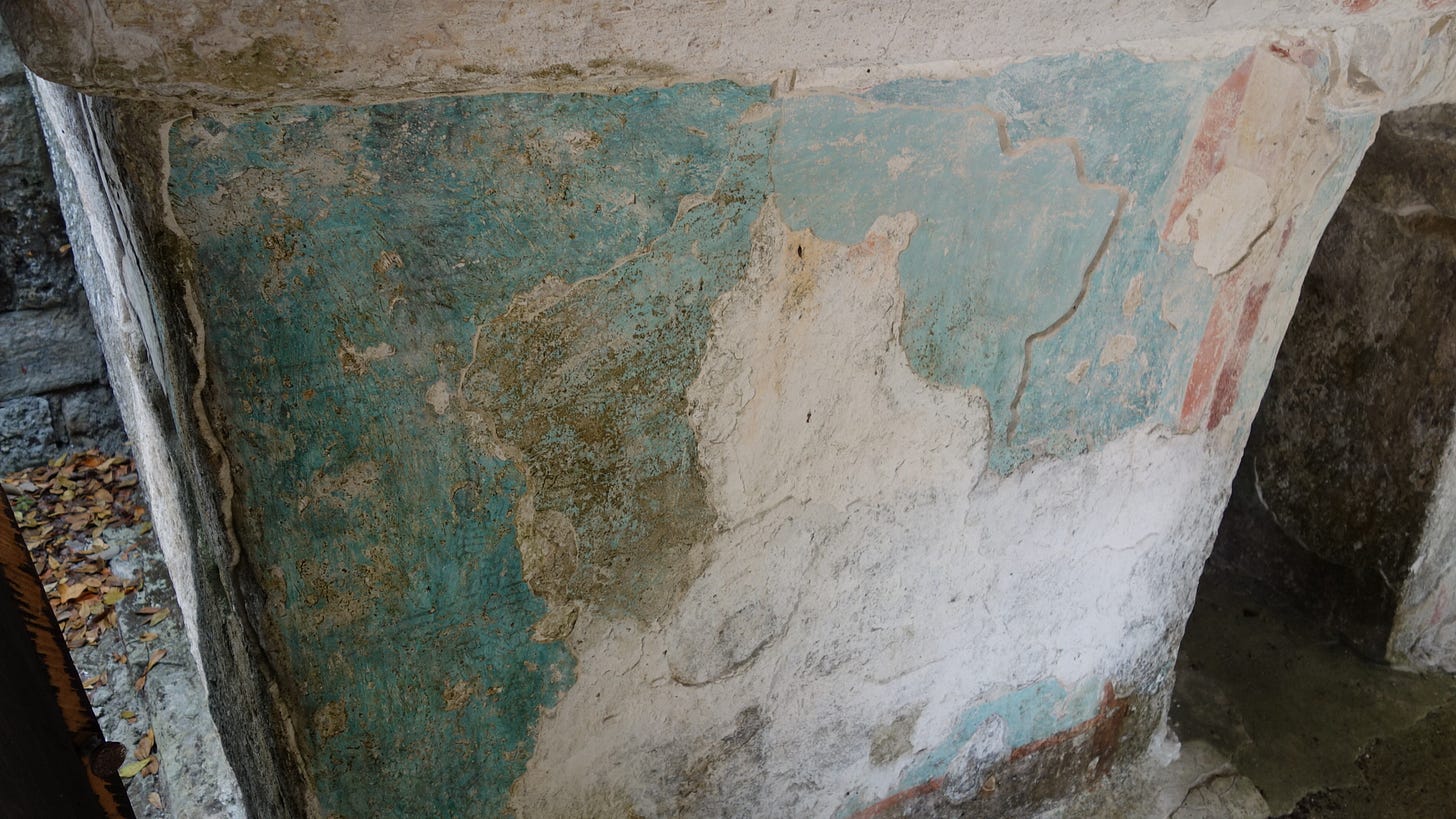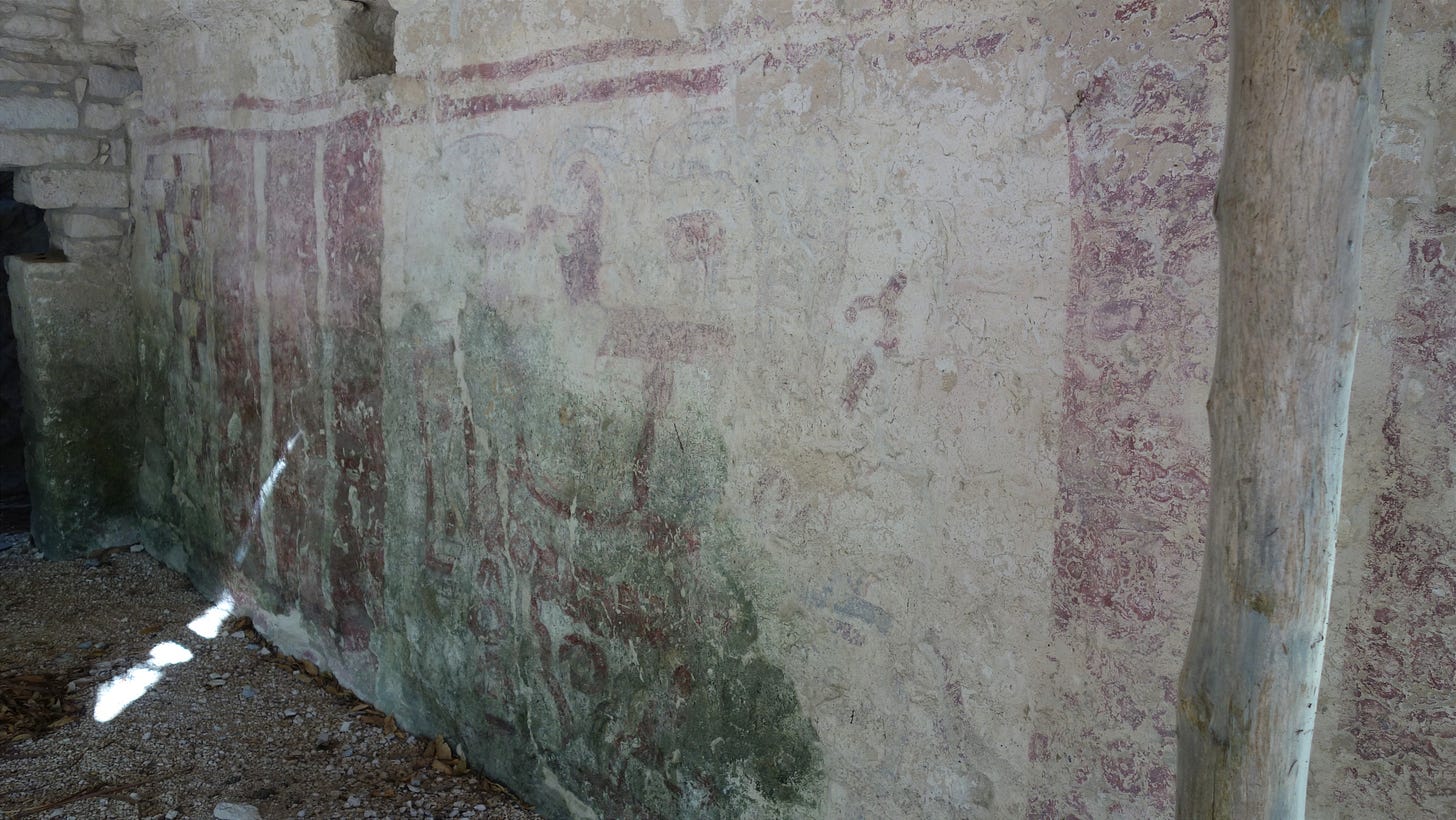House of the Jaguar and the Ancient Maya Blue: Xel-Ha Ruins
Travel Tales from the Land of the Maya #3
The small Temple of the Jaguar at Xel-Ha Ruins was the very first ancient Maya structure I ever set eyes on - and walked through. It was 1995; the site was seldom visited, so none of the structures were closed. We could enter the small temple and marvel at the remnants of paintings and colors on the walls - among them my favorite, the ancient Maya blue.
Dear Reader,
Welcome to another installment of my future travel memoir about exploring the land of the Maya (both ancient structures and present-day towns). If you are new here, you can read the first two posts in this series here:
You can always find the series on the navigation bar of the site, under Travel Tales from the Land of the Maya.
After being stranded on a gorgeous beach for several hours, we were back on the road - in a car we could not lock for the rest of the trip.
Our next stop along the narrow two-lane road was Xel-Ha Archaeological Site.
A small palapa served as the entrance booth, a bicycle leaning against its post, and a rudimentary wooden table serving as a stand for the tickets and a notebook where we signed in. As I wrote our names and place of origin, I couldn’t help but notice we were the first visitors of the day - and I have seen no names for several days prior, and even the week before every visitor seemed to be from some place in Europe.
Besides the Maya laying in a hammock in the “booth”, the site was deserted.
“Las ruinas? Can we see them?” asked Jeff, in his mixed Spanish-English. He’s been there before; He was used to communicating in this manner. As long as he knew a few important words to use, they could always guess the rest.
“Si, si,” the man answered, as he got out of his hammock.
We paid the entrance fee of a few pesos, and we set off on a barely discernible trail.
Walking through sparse tropical vegetation, we ended up near a gorgeous cenote that dropped abruptly from the trail.
Near it stood the small Jaguar Temple and a smaller building across from it.

It was the very first ancient Maya structure I ever saw, and I was in awe! Not because the structure was anything special; a small, rectangular building, it didn’t look like much - until we entered it.
However, I noticed that the building seemed to have been made for me - or at least for people of my height. For once, I felt more comfortable walking through a building than my 6-ft- tall husband.
I kept going in and out through the rooms, marveling at the stucco and the paintings on their walls.
The image of the jaguar the building is named for, red handprints above the doorways, and hundreds of other barely discernible images filled the walls.


I sat for what seemed like hours in front of several drawings on blue background, trying to figure out their meaning.
I could not believe how beautiful the paint was, how clear the images were after all the time they sat abandoned in the jungle. (I’ve seen more faded images in buildings dating from the 19th century.)
But what I enjoyed most in the House of the Jaguar was the blue color on the walls, the unique bright turquoise called Maya blue - Azul Maya.
The color, famous for its resistance to the elements, had spiritual significance for the ancient Maya. Even creating it was part of a ritual. While burning copal incense, they heated the leaves of a native plant, anil (ch’oj in Mayan), and a rare natural clay called palygorskite, fusing them during the process. Besides creating the brilliant color, they also believed the process had great healing powers.
This gorgeous color represented Chaak, the god of rain and agriculture, and everything related to him. Besides using it in murals and other paintings (ceremonial vessels come to mind), they also painted sacrifices to Chaak blue. This included human sacrifices, but more often objects and animals, all painted in Maya blue as an offering to Chaak for rainfall and bountiful harvest.
Centuries and harsh weather did nothing to fade the Maya blue colors in the ancient paintings. Scientists found it even resists chemical solvents and acids.
It is not only weather and time resistant; it is one of the most unique - and beautiful - shade of turquoise blue, my favorite color. No wonder I couldn’t leave the Temple of the Jaguars for a long time.
“If you love this tiny building so much, I can’t wait to show you the rest of the ruins on the Peninsula,” said Jeff, trying to pry me away from it. “We still have a few structures to explore here, too.”
But before moving on, we had a picnic lunch near the cenote. We sat there for a while, listening to the birds, then we followed the shaded trail to the Palace Group.
We emerged from the dark forest into the light at the Mercado (market), one of the two major structures in the group. Both date from the Late Post-Classic Era of the Maya civilization, about 1200-1550 AD. As we walked through the ancient rooms, our only companions were the birds and an iguana laying on the rocks nearby.
Past the Palace Group, the trail led to the Pyramid of the Birds, named for the large fresco on its wall. Small compared to most pyramids, what it lacks in size makes up in the beauty of its well-preserved murals, especially the one that gave the structure its name.
This time, the dominant color is red, still beautiful. The composition, depicting two different types of birds, is even more striking.
Two red frames enclose the pictures of red birds, with long tails, and others, that seem to be yellow parrots with shorter tails. They look like they are flying everywhere.
The frames are separated by a column with a glyph on it. I knew from my readings that the glyph stands for the Maya word, “Ahau”. It means Lord or ruler. It is also the name of one of the days in the Maya calendar.
Even more impressive than the composition itself is the fact that ancient Maya artists painted it sometime between 300 and 600 AD.!
The Birds composition is not the only mural on this pyramid. On the other side, we found a symmetrical composition divided into four rectangles. One of them looks like a checkerboard with red, gray and yellow squares.
The main motif is an anthropomorphic figure with a head dress, bracelets and necklaces. The Maya blue color is present here, too, along with red, white, and yellow.
To be fair, these murals are so well-preserved because they sat buried under a newer structure for centuries. Encasing older structures intact in the newer ones was a common practice among the Ancient Maya in a land where building material was scarce.
Long after they abandoned the site, the newer structure fell apart, revealing the older one we were admiring.
From the Pyramid of the Birds, we returned to the entrance, closing the circle.
With enough daylight still, we drove across the road to Xel-Ha lagoon, a small, quiet park at the time. We only shared it with several locals. A simple wooden walkway led to the water’s edge. Eco-conscious even then, they did not allow anyone to wear sunscreen (this was before reef-safe sunscreen existed); they had all visitors shower before entering the lagoon, and leave everything beside snorkel-gear in a locker at the entrance.
We snorkeled in the crystal-clear water of the lagoon - where fresh water and ocean meet -, then drove on and looked for a place to spend the night.
We found a palapa hut we could rent for the night on a beach nearby. The owner, a fisherman, even made us a simple, but delicious dinner, cooking the fish he caught that day, and adding some rice and fried plantain to it to make it a meal.
About Xel-Ha Ruins
One of the ancient Maya archaeological sites in Quintana Roo, on the Yucatan Peninsula, Xel-Ha was an ancient port city, built to serve the much larger site of Cobá. A combination of two words in Yucatec Maya, Xel - spring/inlet, and Ha - water, the name of the ancient city, reflects this. We could translate it into “Water Inlet”, which is just what Xel-Ha Lagoon is, where the famous and busy water park is located now.
Although it is on the coast, the site doesn’t overlook the sea like Tulum. The ancient Maya used Xel-Ha Lagoon as a port, while building the city in the jungle inland.
Some of its buildings date from the Early Classic Period of the Maya civilizations, as far back as 300-600 AD, though most of its structures are more recent, built between 700 and 1200 A.D. This was the time Xel-Ha became an important port city.
After it lay abandoned in the jungle by the coast for a few centuries, Stephens and Catherwood stumbled upon the site in 1841. They described their journey on the peninsula in the Incidents of Travel in Yucatan, published after their return.
Since then, some of the ruins have been reconstructed, but most of them still lay in the jungle. You can visit the whole site in about an hour and you might still have it all to yourself (we did, even in 2024). You can not enter the Temple of the Jaguars, but you can look inside and notice the blue paint and the red handprints.
We still stop at the site every time we visit the Peninsula, and still find it as quiet, as empty of tourists as ever.
Reference:
Uncovering Ancient Technologies: The Mystery and Symbolism of Maya Blue
Hope you enjoyed the story of my first encounter with an ancient Maya site.
Until next time, all the best,
Emese












Maya Blue is uniquely beautiful! soft yet rich, bold yet earthy..
This series is making me long to get back to that area even more than I already did! It may be a few years still but it is definitely priority. I didn’t expect to love the area as much as I did, when we went for a wedding a few years ago, but I haven’t stopped thinking about how happy I was to be there ever since.